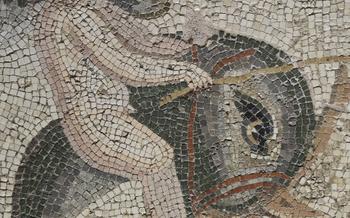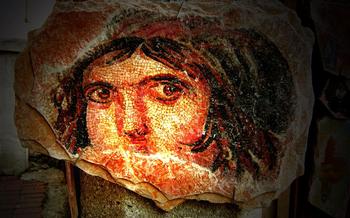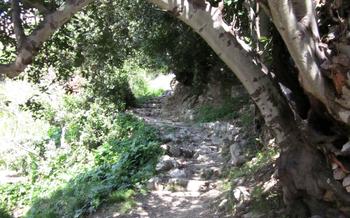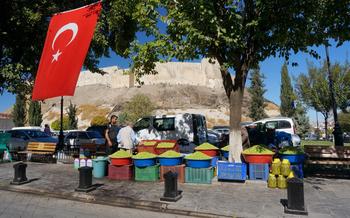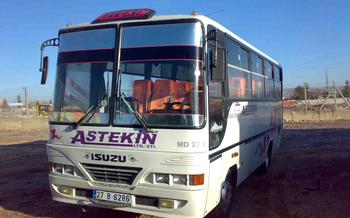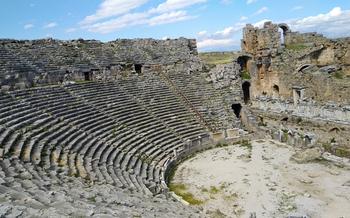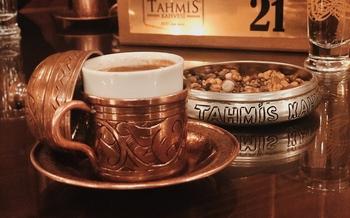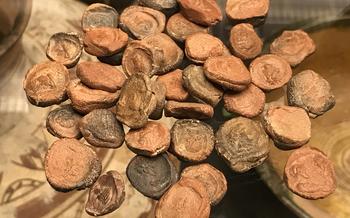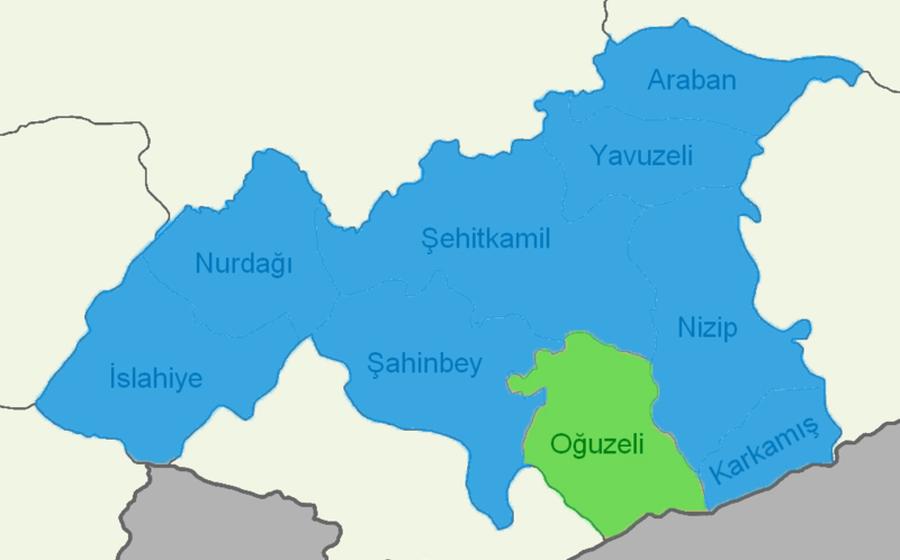
Archeological Park
- Gaziantep Archaeological Park: A Journey Through History
- The Zeugma Mosaics Museum: A Masterpiece Unveiled
- Exploring the Ancient City of Zeugma: A Lost Civilization Rises
- Unveiling the Secrets of the Roman Baths: A Place of Relaxation and Ritual
- The Zeugma Amphitheater: A Stage for Ancient Spectacles
- Discovering the Temple of Zeus: A Place of Worship and Rituals
- Strolling Along the Colonnaded Street: A Gateway to Ancient Commerce
- Exploring the Zeugma Museum: A Treasure Trove of Artifacts
- The Zeugma Olive Oil Museum: A Taste of History and Tradition
- The Zeugma City Walls: Guardians of a Bygone Era
- The Zeugma Necropolis: A Silent City of the Dead
- Gaziantep's Culinary Delights: A Feast for the Senses
- Insider Tip: Gaziantep's Vibrant Culture and Beyond
Gaziantep Archaeological Park: A Journey Through History
The Gaziantep Archaeological Park is a treasure trove of ancient ruins and artifacts, offering visitors a unique glimpse into the rich history and cultural heritage of Turkey. Located in the southeastern city of Gaziantep, the park encompasses the remains of the ancient city of Zeugma, once a thriving metropolis on the banks of the Euphrates River.
Historical Significance: Zeugma played a significant role in the Roman Empire as a strategic military outpost and a major trading center. Its strategic location at the crossroads of major trade routes made it a prosperous and cosmopolitan city.
Excavations and Discoveries: Extensive archaeological excavations conducted in the 1990s and 2000s unearthed a wealth of well-preserved mosaics, sculptures, and other artifacts, shedding light on the city's glorious past. These discoveries have transformed Gaziantep into a major archaeological destination.
Park Layout and Organization: The park is divided into several sections, each showcasing different aspects of Zeugma's history and culture. Visitors can explore the ruins of ancient buildings, admire stunning mosaics and sculptures, and learn about the city's daily life and traditions.
Visitor Facilities and Amenities: The park offers a range of facilities to enhance the visitor experience, including a museum, a visitor center, and well-maintained walkways. Guided tours are available to provide insights into the history and significance of the site.
The Zeugma Mosaics Museum: A Masterpiece Unveiled
Gaziantep's crown jewel, the Zeugma Mosaics Museum, stands as a testament to the artistic prowess and cultural heritage of ancient Zeugma. It houses a breathtaking collection of intricate and exquisitely preserved mosaics that have captivated the world with their beauty and historical significance. These mosaics were meticulously excavated from various sites across Zeugma, including villas, temples, and public buildings, and now reside in this state-of-the-art museum.
The museum showcases an array of stunning mosaics, each narrating a unique story and depicting scenes from mythology, history, daily life, and religious beliefs. The centerpiece of the collection is undoubtedly the renowned "Gypsy Girl" mosaic, a poignant portrayal of a young woman with captivating eyes and an enigmatic smile. This iconic masterpiece has become synonymous with Zeugma and is widely recognized as one of the finest examples of ancient mosaic art.
Beyond the "Gypsy Girl," visitors can marvel at the "Achilles Mosaic," which depicts the legendary hero battling the Trojans, and the "Orpheus Mosaic," illustrating the mythical musician charming wild animals with his enchanting melodies. These mosaics, along with countless others, provide a vivid glimpse into the cultural and artistic landscape of ancient Zeugma.
The Zeugma Mosaics Museum is meticulously organized to enhance the visitor experience. Interactive displays, detailed captions, and multimedia presentations accompany each mosaic, offering insights into their historical context, artistic techniques, and cultural significance. The museum also boasts a well-equipped conservation laboratory, where experts work tirelessly to preserve and restore these priceless artifacts for future generations.
Exploring the Ancient City of Zeugma: A Lost Civilization Rises
The ancient city of Zeugma, once a thriving metropolis on the banks of the Euphrates River, lies within the Gaziantep Archaeological Park. While much of the city remains buried beneath the earth, ongoing excavations have revealed tantalizing glimpses into its rich history and significance.
Zeugma's origins date back to the 3rd century BC when it was founded by Seleucus I Nicator, one of Alexander the Great's generals. Strategically located at the crossroads of major trade routes, Zeugma quickly grew into a prosperous center of commerce and culture. Its wealth and influence attracted people from diverse backgrounds, resulting in a vibrant and cosmopolitan society.
The city's architectural legacy is evident in the impressive ruins that dot the archaeological park. Visitors can explore the remains of temples, theaters, baths, and other public buildings, each offering clues to Zeugma's past. The city's fortifications, once formidable barriers against invaders, stand as testaments to its strategic importance.
Ongoing excavations continue to unearth new treasures from Zeugma's past. Archaeologists have uncovered intricate mosaics, sculptures, and inscriptions that shed light on the city's artistic achievements and cultural heritage. These discoveries provide valuable insights into the daily lives, beliefs, and traditions of Zeugma's inhabitants.
Zeugma's story is one of grandeur, resilience, and ultimately, tragedy. While the city's glory days came to an end with the Arab conquest in the 7th century AD, its legacy lives on in the ruins that stand as silent witnesses to its former glory. Exploring Zeugma is a journey through time, offering a glimpse into a lost civilization that once flourished on the banks of the Euphrates.
Unveiling the Secrets of the Roman Baths: A Place of Relaxation and Ritual
In the heart of Zeugma Archaeological Park, the Roman Baths stand as a testament to the city's once-thriving bathing culture. Built during the 2nd century AD, these baths were a place of relaxation, socialization, and ritual purification. The complex comprised several rooms, including a dressing room, a cold room, a warm room, and a hot room. Each room served a specific purpose and was designed to provide bathers with a unique experience.
The cold room, known as the frigidarium, was the first stop for bathers. Here, they would plunge into a cold pool to cool down and invigorate their bodies. The warm room, called the tepidarium, offered a more moderate temperature, allowing bathers to gradually acclimate to the heat. It served as a transition space between the cold and hot rooms.
The hot room, known as the caldarium, was the centerpiece of the baths. It featured a large heated pool, where bathers could soak and sweat to cleanse and rejuvenate their bodies. The intense heat and steam helped to open pores and release toxins. The caldarium was also used for therapeutic purposes, as the heat was believed to have healing properties.
After bathing, visitors could relax in the adjacent lounging area, known as the apodyterium. Here, they could socialize, chat with friends, and enjoy refreshments. The apodyterium was often decorated with frescoes and mosaics, creating a pleasant and inviting atmosphere.
The Roman Baths in Zeugma offer a glimpse into the daily lives and bathing rituals of the city's ancient inhabitants. They stand as a testament to the importance of personal hygiene and well-being in Roman society, and their well-preserved state allows visitors to experience a piece of history firsthand.
The Zeugma Amphitheater: A Stage for Ancient Spectacles
Gaziantep's Zeugma Amphitheater stands as a testament to the grandeur of ancient Roman entertainment. Built in the 2nd century AD, this impressive structure once hosted a variety of events, including gladiator fights, theatrical performances, and other spectacles that captivated the city's inhabitants.
With a seating capacity of around 20,000 spectators, the amphitheater boasted a remarkable architectural design. Its elliptical shape ensured excellent acoustics, while the tiered seating provided clear views of the central arena. The stage area, adorned with intricate carvings and decorative elements, served as the focal point for the thrilling events that unfolded within.
Gladiatorial contests were a particularly popular form of entertainment in ancient Zeugma. These fierce battles, often fought to the death, showcased the skill, strength, and courage of the gladiators. The amphitheater's design facilitated these contests, with its carefully constructed barriers and protective features ensuring the safety of the spectators.
In addition to gladiatorial fights, the amphitheater also hosted theatrical performances, musical concerts, and other cultural events. These spectacles provided a platform for local artists, musicians, and performers to showcase their talents and entertain the masses. The amphitheater's acoustics and intimate atmosphere created an immersive experience for the audience, transporting them into the world of ancient drama and spectacle.
Today, the Zeugma Amphitheater stands as a symbol of Gaziantep's rich history and cultural heritage. Although partially restored, it retains its grandeur and evokes a sense of awe and wonder. Visitors can explore the amphitheater's ruins, imagining the roar of the crowd and the excitement that filled the air during ancient times. The Zeugma Amphitheater serves as a reminder of the enduring legacy of Roman entertainment and its profound impact on the cultural and social fabric of ancient Zeugma.
Discovering the Temple of Zeus: A Place of Worship and Rituals
In the heart of the ancient city of Zeugma, lies the sacred Temple of Zeus, a testament to the religious devotion and spiritual beliefs of its inhabitants. Dedicated to the mighty Greek deity Zeus, the temple served as a place of worship, rituals, and ceremonies, holding a central role in the cultural and religious life of Zeugma. Though time has eroded its grandeur, the remnants of the temple offer a glimpse into the spiritual practices and beliefs of this ancient civilization.
The Temple of Zeus was constructed in the Hellenistic period, reflecting the cultural influences of the Greek settlers who founded Zeugma. Its architectural design and layout adhered to classical Greek traditions, featuring a rectangular structure with an elevated platform and a series of columns supporting the roof. Within the temple, a large statue of Zeus, carved from marble or bronze, would have stood as the focal point of worship, embodying the divine presence of the god.
Around the statue, various altars and offerings were placed, where devotees would make sacrifices and perform rituals in honor of Zeus. These rituals might have included prayers, libations, and animal sacrifices, accompanied by hymns, music, and ceremonial dances. The temple also served as a place for religious festivals and celebrations, bringing the community together to honor their patron deity and seek his blessings.
Excavations conducted at the site have uncovered a wealth of artifacts and inscriptions that shed light on the religious practices and beliefs associated with the temple. These include votive offerings, such as statuettes, pottery, and coins, as well as inscriptions invoking Zeus's protection and guidance. The discovery of these artifacts provides valuable insights into the spiritual lives of the people of Zeugma and their relationship with the divine.
Strolling Along the Colonnaded Street: A Gateway to Ancient Commerce
In the heart of Ancient Zeugma, the Colonnaded Street served as a vibrant hub of commerce and social interaction. Stretching for over 400 meters, this impressive thoroughfare was lined with rows of imposing columns that supported a protective roof, creating a shaded promenade for shoppers and traders.
The street was a bustling marketplace, where merchants displayed their wares in small shops and stalls. Vendors offered a diverse array of goods, from exotic spices and textiles to handcrafted pottery and jewelry. The air was filled with the sounds of haggling, laughter, and the clinking of coins as buyers and sellers negotiated prices.
Beyond its commercial significance, the Colonnaded Street also served as a place for social gatherings and community events. Residents strolled along the street, catching up on the latest news, discussing politics, or simply enjoying each other's company. It was a place to see and be seen, a place to make connections and forge relationships.
Today, visitors can still walk along the ancient Colonnaded Street, imagining the hustle and bustle of bygone days. The well-preserved columns and stone pavement evoke a sense of awe and wonder, transporting visitors back in time to the thriving metropolis that was Zeugma.
Exploring the Zeugma Museum: A Treasure Trove of Artifacts
Located within the Gaziantep Archaeological Park, the Zeugma Museum stands as a testament to the rich history and cultural heritage of the ancient city of Zeugma. It houses a remarkable collection of artifacts and exhibits that provide a glimpse into the everyday life, traditions, and artistry of this once-thriving metropolis.
The museum is home to a diverse array of objects, including sculptures, mosaics, jewelry, pottery, glassware, and coins. These artifacts offer valuable insights into the artistic skills, craftsmanship, and cultural influences that shaped Zeugma. Visitors can admire the intricate details of the stone carvings, the vibrant colors of the mosaics, and the delicate designs of the jewelry, each piece telling its own story.
Among the highlights of the museum's collection is a stunning mosaic depicting the myth of Leda and the Swan. This exquisitely crafted work of art showcases the exceptional skill and artistry of Zeugma's mosaicists. Another must-see exhibit is a collection of bronze figurines, which provide a glimpse into the religious beliefs and practices of the ancient city's inhabitants.
The Zeugma Museum also offers educational programs and resources to enhance the visitor experience. Guided tours led by knowledgeable experts provide in-depth insights into the significance of the artifacts and the history of Zeugma. Interactive displays and multimedia presentations engage visitors of all ages, making learning about this ancient civilization both enjoyable and informative.
The Zeugma Olive Oil Museum: A Taste of History and Tradition
Gaziantep, the heart of southeastern Anatolia, is not only renowned for its rich history and cultural heritage but also for its culinary delights. Among these, olive oil holds a special place, deeply intertwined with the region's traditions and gastronomy. The Zeugma Olive Oil Museum, a unique and immersive experience, invites visitors to delve into the history, production, and significance of this liquid gold.
The museum, housed in a renovated traditional olive oil factory, offers a journey through time, showcasing the ancient techniques and tools used to extract and process olive oil. Visitors can witness the transformation of olives into the precious liquid, gaining insights into the skills and dedication of olive oil producers throughout the ages.
Interactive exhibits and displays provide a comprehensive overview of the cultural and historical significance of olive oil in Zeugma. Visitors can learn about the role it played in trade, religious rituals, and everyday life. The museum also highlights the unique properties and health benefits of olive oil, emphasizing its importance in Mediterranean cuisine.
A visit to the Zeugma Olive Oil Museum is not complete without sampling the local delicacies infused with the flavors of freshly pressed olive oil. Visitors can indulge in traditional dishes prepared with local ingredients, experiencing the culinary heritage of Zeugma firsthand.
Whether you are a history buff, a culinary enthusiast, or simply curious about the traditions of this ancient city, the Zeugma Olive Oil Museum offers a delightful immersion into the world of olive oil, leaving you with a lasting appreciation for this liquid treasure.
The Zeugma City Walls: Guardians of a Bygone Era
Standing tall and proud, the Zeugma city walls narrate tales of resilience and protection from a bygone era. Constructed in the 3rd century BC, these sturdy fortifications once encircled the ancient city, safeguarding its inhabitants from external threats and invasions. Built using local stone, the walls were meticulously crafted, showcasing the ingenuity and engineering prowess of Zeugma's builders.
The walls stretched for approximately 4 kilometers, forming an impressive perimeter that encompassed the city's vital districts. They featured a series of strategically placed towers and gates, allowing for controlled access and defense. The towers, spaced at regular intervals, provided elevated vantage points for guards to keep watch and communicate with each other.
Over the centuries, the walls bore witness to numerous historical events, withstanding sieges and attacks from various empires. Their resilience is a testament to the strength and determination of Zeugma's people. Today, visitors can still marvel at the remnants of these ancient fortifications, which offer a glimpse into the city's rich and storied past.
The Zeugma Necropolis: A Silent City of the Dead
Lying just outside the ancient city walls, the Zeugma Necropolis is a poignant reminder of the lives and deaths of Zeugma's inhabitants. This vast expanse of tombs and burial chambers offers a glimpse into the funerary practices and beliefs of this once-thriving metropolis.
Zeugma's necropolis is a treasure trove of archaeological information, providing insights into the social structure, religious beliefs, and cultural practices of the city's population. The tombs vary in size and complexity, reflecting the social status and wealth of the deceased. Some tombs are simple pits, while others are elaborate structures with multiple chambers and intricate decorations.
Excavations have uncovered a wide range of artifacts within the tombs, including jewelry, pottery, coins, and personal belongings. These objects provide valuable clues about the daily lives and customs of Zeugma's residents. Inscriptions on tombstones and funerary objects often reveal the names, occupations, and family relationships of the deceased, adding a personal touch to the archaeological record.
The Zeugma Necropolis is a powerful reminder of the mortality of ancient Zeugma's inhabitants and offers a unique perspective on their beliefs about the afterlife. It is a place where the past and present converge, as visitors can wander among the silent tombs and contemplate the lives of those who once called this city home.
Gaziantep's Culinary Delights: A Feast for the Senses
Gaziantep is not only a city of ancient wonders but also a culinary paradise. The city's rich history and cultural diversity have given rise to a unique and flavorful cuisine that has gained international acclaim. From mouthwatering kebabs to savory pastries, Gaziantep's culinary scene is a must-experience for any traveler.
One of the most iconic dishes of Gaziantep is the lahmacun, a crispy flatbread topped with minced meat, vegetables, and spices. Another must-try is the beyran, a hearty lamb soup served with rice and crispy bread. For those with a sweet tooth, the katmer, a flaky pastry filled with nuts and syrup, is a local favorite.
Gaziantep is also known for its vibrant markets, where visitors can find an array of spices, dried fruits, nuts, and local delicacies. The Zincirli Bedesten, a historical covered market, is a great place to experience the city's culinary heritage and sample some of its famous street food.
Insider Tip: For a truly authentic dining experience, venture into the narrow streets of the old city and explore the local restaurants and eateries. Many of these hidden gems serve traditional dishes passed down through generations, offering a taste of Gaziantep's culinary history.
Insider Tip: Gaziantep's Vibrant Culture and Beyond
Gaziantep is not just about ancient ruins and historical sites; it's also a vibrant city brimming with culture, traditions, and culinary delights. Immerse yourself in the local festivities by attending the annual Gaziantep International Film Festival, where you can catch screenings of local and international films. The city also hosts the Gaziantep Biennial, a contemporary art exhibition that showcases the works of talented Turkish and international artists.
Venture beyond the city center to explore nearby attractions such as the Halfeti Village, known for its unique black roses, or take a day trip to the ancient city of Rumkale, perched atop a rocky peninsula overlooking the Euphrates River.
Plan your visit to Gaziantep during the spring or fall to enjoy pleasant weather and avoid the summer heat. The city is well-connected by air and road, with regular flights and bus services from major cities in Turkey and abroad. Numerous tour operators offer guided tours of the Archaeological Park and other historical sites, providing insights into the rich history and culture of Zeugma and Gaziantep.
Whether you're a history buff, a culture enthusiast, or a foodie, Gaziantep offers an unforgettable experience that will leave you enchanted and inspired. So, come prepared to be amazed by the treasures that await you in this vibrant and welcoming city.
